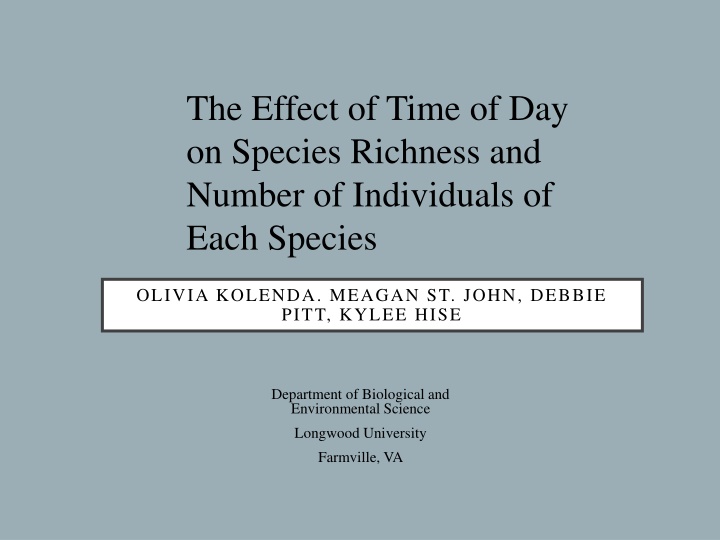Effect of Time of Day on Bird Species Richness and Individuals
The study investigates how the time of day impacts the species richness and number of individuals of birds at a specific feeder in Longwood University's Environmental Education Center. Through observational studies and counting, the researchers aim to determine if there are differences in bird populations during morning, noon, and afternoon periods. Hypotheses include assessing the diversity and richness of species, as well as the number of individuals of each species present. The study area is within Lancer Park in Farmville, VA. Different images illustrate the birds' feeding patterns, study area, and expected species. Tags: Bird Species, Time of Day, Species Richness, Observational Study, Environmental Science.
Download Presentation

Please find below an Image/Link to download the presentation.
The content on the website is provided AS IS for your information and personal use only. It may not be sold, licensed, or shared on other websites without obtaining consent from the author.If you encounter any issues during the download, it is possible that the publisher has removed the file from their server.
You are allowed to download the files provided on this website for personal or commercial use, subject to the condition that they are used lawfully. All files are the property of their respective owners.
The content on the website is provided AS IS for your information and personal use only. It may not be sold, licensed, or shared on other websites without obtaining consent from the author.
E N D
Presentation Transcript
The Effect of Time of Day on Species Richness and Number of Individuals of Each Species OLIVIA KOLENDA. MEAGAN ST. JOHN, DEBBIE PITT, KYLEE HISE Department of Biological and Environmental Science Longwood University Farmville, VA
BACKGROUND Wild birds follow a regular daily feeding activity. Small birds present maximum activity of feeding during morning and evening. Many factors may affect the time of caloric intake.
Feeding Pattern of White-Crowned Sparrows
SPECIFIC AIM Does time of day affect the total number of birds? Does time of day affect the species richness of birds? To test this, we studied a specific bird feeder behind the EEC in Lancer Park.
STUDY AREA: Longwood University Environmental Education Center (EEC) in Lancer Park located in Farmville, VA. Perimeters: The birds within close perimeters of the bird feeder are the ones that will be counted.
HYPOTHESES Ho1: There is no difference in the species diversity and richness of birds at one feeder bird feeder located at the Environmental Education Center at Longwood University based on different times of day (morning, noon, and afternoon). Ho2: There is no difference in the number of individuals of each species of birds at one feeder located at the Environmental Education Center at Longwood University based on different times of day (morning, noon, and afternoon).
TYPE OF STUDY Observational study of point counts Treatment variables: Time of day Temperature Response variables: Diversity in bird population at feeder Number of birds in each species
ADDITIONAL PARAMETERS: IN VIRGINIA The average annual temperature is 13.5 degrees Celsius (56.3 degrees Fahrenheit). The average high temperature for March is 15.1 degrees Celsius (59.18 degrees Fahrenheit). The average low temperature for March is 0.2 degrees Celsius (32.36 degrees Fahrenheit).
METHODOLOGY Collecting Samples The medium-height bird feeder, second from the left, will be studied at the EEC. For each time of day, data was recorded for 10 minutes One tally mark was recorded for each bird seen, according to species Only birds approaching the feeder were accounted for If a bird fled the area and then returned, it was tallied again
METHODOLOGY Collecting Samples Birds will be identified using the Merlin Bird ID app on mobile devices Data will be statistically analyzed by ANOVA tests and Tukey Honestly Significant Differences tests Point count is the method used for bird counting
NUMBER OF SPECIES OF BIRDS PRESENT BASED ON THREE DIFFERENT TIMES OF THE DAY. 4.5 4 3.5 Number of speceis 3 2.5 2 1.5 1 0.5 0 9AM 12PM 4PM
TOTAL NUMBER OF BIRDS PRESENT BASED ON THREE DIFFERENT TIMES OF THE DAY. 25 20 Total number of birds 15 10 5 0 9AM 12PM 4PM
THE EFFECT OF TEMPERATURE ON TOTAL NUMBER OF BIRDS PRESENT. 35 30 Total number of birds 25 20 15 10 5 0 0 2 4 6 8 10 12 14 16 18 20 Temperature (degrees Celsius)
THE AVERAGE DOMINANCE PRESENTED BY DIFFERENT BIRD SPECIES BASED ON THE TIME OF DAY. 2.5 2 Dominance (D) 1.5 1 0.5 0 9AM 12PM 4PM
THE HETEROGENEITY PRESENTED BY DIFFERENT BIRD SPECIES BASED ON THE TIME OF DAY. 2 1.8 1.6 Heterogeneity (H') 1.4 1.2 1 0.8 0.6 0.4 0.2 0 9AM 12PM 4PM
LITERATURE CITED Rollfinke, B., & Yahner, R. 1990. Effects of Time of Day and Season on Winter Bird Counts.The Condor. 92(1):215-219. O'Leske, D., Robel, R., & Kemp, K. 1997. Fall Point Counts: Time of Day Affects Numbers and Species of Birds Counted.Transactions of Science.100(3/4):94-100. the Kansas Academy of
THANK YOU!!! Dr. Henk Department of Biological Sciences Longwood University























